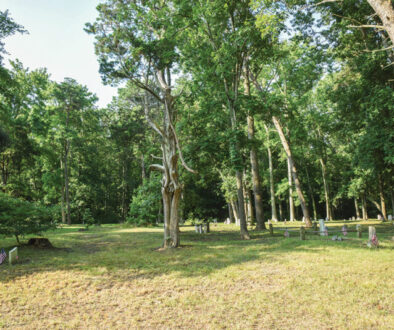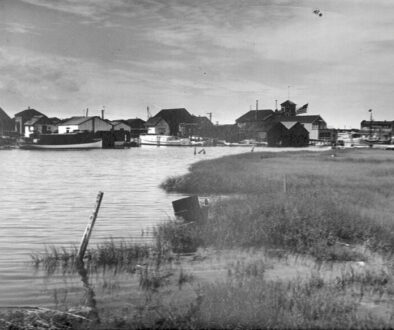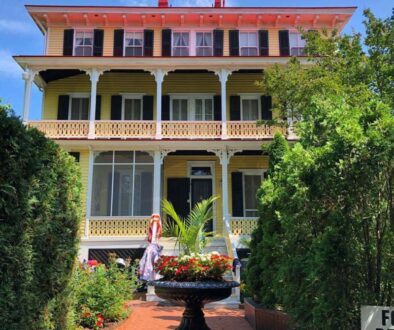The Tip of the Funnel

I have a new birding friend from Cape May; we will call him Jim for this article. Jim is recently retired, has lived in Cape May for most of his life, raised a family of wonderful kids who are now wonderful adults, and is plugged into the cultural scene in Cape May. Jim knows where he lives. He lives in one of the world’s greatest beach towns. Jim goes to the beach, because if you live in one of the greatest beach towns and don’t go to the beach, you could be rightfully accused of wasting a perfectly good opportunity.
But Cape May—and by Cape May I mean the greater Cape May region, including Cumberland and Atlantic Counties—is amazing for another spectacle as great or greater than the sand between my toes as I write this (and this, coming from someone who loves the beach more than just about anything). That spectacle is fall migration, and fall migration in Cape May is flat-out magical. There’s really no other way to put it. I’m a scientist, skeptical of the things I cannot see, touch, hear, or taste, but I do not hesitate to describe fall in Cape May as simply magic. Of course, as with any good illusion, the secret is in the sleight of hand, and in this case that sleight of hand is really time—and darkness. So much of fall migration happens at night when most of us are sound asleep, and by morning everything around us has changed. Like waking up on Christmas morning to find more presents under the tree than when you went to bed. The cast of characters who were here all summer have begun to disappear, and are replaced by new characters, arriving in pulses throughout the fall, seemingly from thin air. Here I’m referring to birds, but it happens with many species, from butterflies to moths and dragonflies too.
To decode this illusion, you must think about the geography of our coastline relative to the landscapes to our north, east, and west. To our north are forested areas that include the boreal zone of Southern Canada and the northern United States; stretching west, clear across Canada and eventually Alaska. This zone harbors billions of breeding birds including the North American Wood Warblers, a diverse group of colorful songbirds, but also flycatchers, orioles, grosbeaks, tanagers, woodpeckers, nuthatches—the list goes on, to the tune of over 400 species which actively migrate south in the autumn to take advantage of food resources in more tropical climes as the insect populations plummet in the temperate winter. While certain groups of animals, called “diurnal migrants”—such as birds of prey including hawks, eagles, and falcons—migrate during the day, a very large number of birds, bats, and bugs migrate at night. There are many reasons for this evolutionary strategy including lower atmospheric turbulence at night, and less aerial predators, to name just two. Regardless, many species of bird, bat, and bug migrate hundreds to thousands to even tens of thousands of feet above the earth, heading south out of the boreal and temperate zones to our north.
But what makes Cape May such a special place to witness the spectacle of migration?
To answer this question, we need to employ a little visual. Either on a physical map, or in your mind’s eye, draw a line from the eastern Great Lakes southeast to Cape May, and draw another line from the east coast of Newfoundland southwest to Cape May. You’ve now drawn a “V” which you can think of as a funnel, with the tip of that funnel at Cape May. This is why the magic happens here. Each autumn, as cold fronts move east across the country, and northwest winds build in behind each front, millions of years of evolution trigger birds to migrate south after sunset, and while doing so, the northwest winds drift them to the east, or more specifically, to the east coast. Songbirds aren’t good swimmers, and with few exceptions (although the exceptions can be extraordinary) they would rather not be drifted out to sea, so they compensate for that drift as they near the Atlantic, effectively concentrating right along the coast as they exit the tip of the funnel at Cape May. This phenomenon occurs in a precious few other places, but in the fall, Cape May is it. This is Mecca for bird migration enthusiasts, and thanks to many conservation organizations, it still provides opportunities for birds to seek shelter and refuel before the next leg of their journey.


So, there you have it: the solution to the illusion. I apologize for not alerting you to any imminent spoilers, but I assure you that knowing how the magic happens doesn’t take away from the experience you can have in Cape May following a cold front in autumn.
This model holds true not just for the nocturnal migrants mentioned above, but also for birds of prey: eagles, hawks and falcons, as well as water birds such as loons, grebes, ducks, geese, Northern Gannets, and cormorants, to name a few. And of course, it’s not limited to birds either, as butterflies, moths, and dragonflies include species which migrate through Cape May on the same systems as birds do. The most notable example, of course, is the fabulous Monarch Butterfly (Daunaus plexippus) which migrates through Cape May in massive numbers during September and October, and as the nights get cooler, will communally roost in the dune vegetation at Cape May Point before heading south, and eventually to the mountains of northern Mexico, on the next day of good flight conditions.
But the bird migration spectacle in Cape May is second to none, and on an early September night last year I waited, with great anticipation, for a cold front to pass. With northwest winds in the forecast overnight I knew it should be good for migration, so I dragged Jim out to Beach Avenue under the cover of dark, and we found a quiet place, safe from loud HVAC systems, atop an unnamed hotel’s rooftop deck. We commandeered two lounge chairs and, lying flat on our backs, cupped our ears to the star-studded inky black. The calls were mostly faint at first, but once in a while we’d hear a louder one, and even more exciting, sometimes we could see the underside of a migrating songbird as the lights from Beach Avenue illuminated them for a fleeting moment as they passed. The birds we were hearing were anywhere from several hundred to over 1000 feet above the ground (there are many higher up, with average heights around 3500 feet, but you’ll need a microphone hear them). Warblers included American Redstarts, Black and White, and Northern Parula; several Swainson’s Thrushes gave their signature flight call, similar to the Spring Peeper, a species of frog. The flight wasn’t limited to songbirds either; Green Heron, Solitary Sandpiper, and even a Caspian Tern called overhead during our nocturnal vigil.
Research on nocturnal flight calling has shown that call rates increase closer to the coast and over water, suggesting that birds are using the call and response to determine whether they’re in the right place, or rather where most of the birds aloft are, and are not. It feels a little like a game of Marco Polo, with a little more peeking, and everybody being “it.” In most cases these birds are programmed in their DNA with a bearing and some idea of how far they ultimately need to go to reach their wintering grounds. In many songbirds, and most shorebirds, adults leave the breeding grounds first, and young follow behind days to weeks later, meaning that young birds are making the journey solely on some genetic programming of an internal compass. These flight calls may serve as a check to see whether there are like-species in the air at the same time, suggesting they’re all heading in the right direction. For most of these land birds migrating at night, they may put on 100 or more miles before settling down for the following day, but as I mentioned above, there are some pretty amazing exceptions.

Jim and I returned to this rooftop oasis throughout the fall on clear nights with good migration conditions, and on one October night we heard many buzzy calls of a species we see quite frequently in spring but less so in fall. These are the calls of the Blackpoll Warbler. This little bird weighs on average between 10 to 15 grams, but in the fall it more than doubles its weight before setting out on a marathon journey from the Canadian Maritimes and New England to South America. For three consecutive days and nights this species flies continuously over water, way out over the Gulf Stream, with no opportunity to land, save for some that may stop in the Caribbean if they experience adverse conditions. The ones Jim and I were hearing may have been launching off of the coast at the Cape May Convention Hall, or possibly moving a bit farther south before heading out over the Atlantic. Alan Brady, longtime member of the Delaware Valley Ornithological Club and avid Cape May Point birder, once told me of an amazing experience he had out on a pelagic trip over 100 miles off of New Jersey dozens of years ago.
“I woke at some point in the night, maybe 1:00am or so, and asked the mate where we were. He said ‘about 100 miles offshore, in the canyons’. Walking out to the stern I immediately heard flight calls which I recognized as Blackpoll Warbler. There were hundreds of them, streaming overhead going south; the flight went on for hours and eventually I went back to bed thoroughly excited about my experience. Interestingly, these birds must have been flying quite high because come morning we barely saw a handful of them but could still hear more moving above us out of sight.”
Alan passed away in 2014, but every time I hear nocturnal migration of Blackpolls, I remember him and his fantastic story…and then think of someone on the north coast of South America waking up one morning in October to a tree full of Blackpolls which appeared like a magician pulling a black and white rabbit out of a hat. The illusion of apparition, yet the true story of their origin is even more magnificent.
Jim is amazed by what is happening overhead, under the cover of dark, and who can blame him? But we humans are visual creatures, and while the nocturnal event holds many secrets and much intrigue, the main event means walking Cape May at daybreak, as many birds, sometimes in the tens of thousands, find shelter right here on Cape Island, and many more across the greater Cape May region. You will know the truth: that many of these birds were flying sky high only hours ago, but now they’ve switched gears in search of food and water and shelter from predators. Watch as the day warms, and the diurnal migrants such as hawks and falcons begin to take to the sky…members of the day-shift, looking at those nocturnal migrants not as compatriots of the bird world, but rather potential fuel. The interactions of these groups of birds is nothing short of spectacular, and often you’ll hear the scream of a Northern Flicker (a species of woodpecker) as it gets strafed by a hungry Cooper’s Hawk. This is the sound of fall in Cape May.

If you’ve come to Cape May for exploring nature beyond the sandy beaches, then some of this information may not be new to you. If you haven’t thought about the wild side of Cape May before, then you’re reading this just in time. While August is a starting point for fall migration, and is exceptional for dragonfly, butterfly, and moth diversity, September is peak for long-distant migrant songbird diversity. The first two weeks of October are prime time for songbird and raptor diversity, while later in October is magical for big concentrations of short-distance migrants as well as lingering long-distance birds. October is also the biggest month for Monarch numbers, and later in October as the temperature drops, monarch roosts can be found in the trees along the dunes at Cape May Point. As November rolls around, sparrows and other short-distance migrants and winter residents build in Cape May, while the larger raptors including Golden Eagles and Northern Goshawks show up in earnest. Offshore waterbird numbers build to epic proportions in November. The Avalon Seawatch experiences days of over 100k birds, building to near one million total passage between September 22nd and December 22nd. By December, migration belongs to the waterbirds, as skeins of sea ducks, Northern Gannets, and Red-throated Loons move south past Cape May, and while land bird migration may be slow, there are many birds that bred farther north which are now taking up winter residency in the Cape May region.
I ask Jim if he has a favorite aspect of birding in Cape May so far, and he doesn’t hesitate: “Fall,” he says, “because every day is different, and you never know what you’re going to get when you wake up.” Such wisdom from a new birder; I couldn’t agree more.
Want to learn more about everything Cape May has to offer in Fall? The New Jersey Audubon’s Cape May Bird Observatory and Nature Center of Cape May have something for everyone. Come join their programs and/or learn from interpretive naturalists at their daily migration counts.
More info at https://njaudubon.org/centers/cape-may-bird-observatory/



